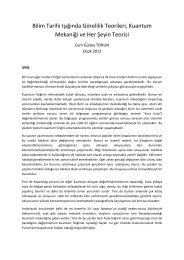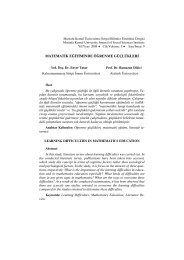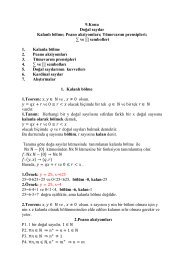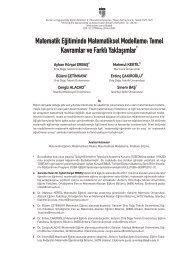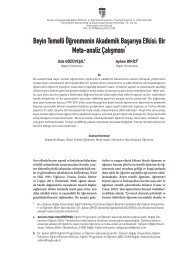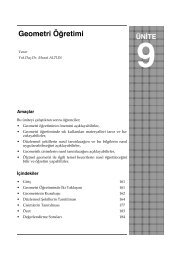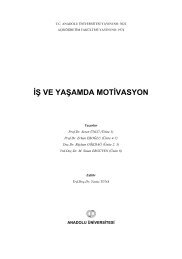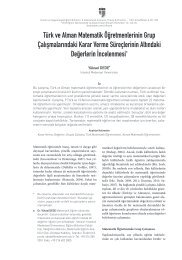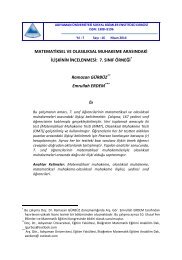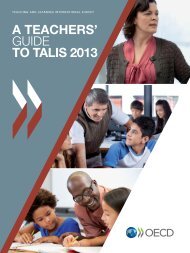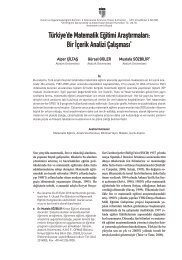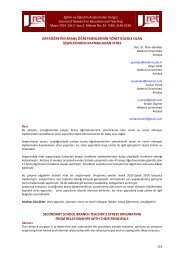Ufuk-U_niversitesi-SBE-Dergisi-S-ayı-5-kopya
Ufuk-U_niversitesi-SBE-Dergisi-S-ayı-5-kopya
Ufuk-U_niversitesi-SBE-Dergisi-S-ayı-5-kopya
Create successful ePaper yourself
Turn your PDF publications into a flip-book with our unique Google optimized e-Paper software.
KAYNAKÇAAlberto P. A, ve Troutman A. C. (2013). Applied behavior analysis for teachers (9th ed.)Englewood Cliffs, NJ: Prentice Hall. Beler, Y., ve Avcı, S. (2011). Öğretim farklılaştırılmasında etkili bir strateji: Katlı öğretim.Ahi Evran Ü<strong>niversitesi</strong> Eğitim Fakültesi <strong>Dergisi</strong>, 12, 109-126. Carolan, J., ve Guinn, A. Differentiation: Lessons from master teachers. EducationalLeadership, 64, 44-47. Collins, B. C. (2012). Systematic instruction for students with moderate and severedisabilities. Baltimore: Paul H. Brookes Publishing Co. Dyck, N., ve Pemberton, J. B. (2002). A model for making decisions about text adaptations.Intevention in School and Clinic, 38, 28-35. Gürsel, O. (2008). Özel eğitimde değerlendirme. İ.H.Diken (Ed.). Özel eğitime gereksinimiolan öğrenciler ve özel eğitim içinde (s. 137-165). Ankara: Pegem Akademi. Güzel Özmen, R. (2008). Öğrenme güçlüğü olan öğrenciler. İ. H. Diken (Ed.). Özel gereksinimi olan öğrenciler ve özel eğitim içinde (s. 335-‐366). Ankara: Pegem Akademi. Hall, T. (2002). Differentiated instruction. www.cast.org/publications/ncac/ncac-diffinstruc.htmladresinden 31.01.2014 tarihinde edinilmiştir. Karadağ, R. (2010). İlköğretim Türkçe dersinde farklılaştırılmış öğretim yaklaşımınınuygulanması: Bir eylem araştırması. Y<strong>ayı</strong>nlanmamış doktora tezi, AnadoluÜ<strong>niversitesi</strong>, Eğitim Bilimleri Enstitüsü, Eskişehir. Kargın, T., Güldenoğlu, B., ve Şahin, F. (2010). Genel eğitim sınıflarındaki özel gereksinimli öğrenciler için yapılması gereken uyarlamalara ilişkin sınıf öğretmenlerinin görüşlerinin incelenmesi. Kuram ve Uygulamada Eğitim Bilimleri <strong>Dergisi</strong>, 10, 2431-2464. Kılıç, M. (2013). Öğrenmenin doğası. B. Yeşilyaprak (Ed.). Gelişim psikolojisi: Gelişimöğrenme-öğretim(10. baskı) içinde (s.166-195). Ankara: Pegem Akademi. Kontaş, H. (2012). Üstün yetenekli çocukların eğitiminde farklı stratejiler. Geleceğin Mimarı Üstün Yetenekliler Sempozyumu'nda sunulan bildiri, Tekirdağ. Levy, H. M. (2008). Meeting the needs of all students through differentiated instruction:Helping every child reach end exceed standarts. The Clearing House, 82, 161-164. Logan, B. (2011). Examining the diffrentiated instruction.www.aabri.com/manuscripts/11888. adresinden 25.01.2014 tarihinde edinilmiştir. Prater, M.A. (2003). She will succeed! Strategies for success in ınclusive classrooms.Teaching Exceptional Children, 35, 58-64. Prater, M.A. (2006). Teaching strategies for students with mild to moderate disabilities. NewJersey: Pearson Allyn & Bacon. Rock, M.L., Gregg, M., Ellis, E., ve Gable, R. A. (2008). Reach: A framework fordifferentiating classroom instruction. Preventing School Failure, 52, 31-47. Schloss, P. J., ve Smith, M. A. (1994). Applied Behavior Analysis in the classroom. Boston:Allyn & Bacon. Tekin-İftar, E., ve Kırcaali-İftar, G. (2012). Özel eğitimde yanlışsız öğretim yöntemleri.Ankara: Vize Y<strong>ayı</strong>ncılık. Tomlinson, C. A. (1995). Deciding to differentiate instruction in the middle school: Oneschool's journey. Gifted Child Quarterly, 39, 77-114. Tomlinson, C. A. (2001). Differentiated instruction in the regular classroom: What does itmean? How does it look? Understanding Our Gifted, 14, 3-6. Tomlinson, C. A. (2005). Grading and differentiation: Paradox or good practice? Theory intoPractice, 44, 262-269. Vuran, S. (2013). Davranış problemleri ile baş etme. H. İ. Diken (Ed.). İlköğretimdekaynaştırma içinde (s. 260-287). Ankara: Pegem Akademi. 122





